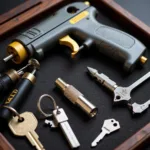Working on a 1950s car is a labor of love, requiring a different set of tools than modern vehicles. These classic cars, with their simpler mechanics and robust construction, demand specialized equipment for proper maintenance and repair. Understanding the right tools for working on a 1950s car is crucial for any enthusiast or mechanic. This guide will explore the essential tools you need to keep your vintage beauty running smoothly.
Understanding the Basics: Tools for Working on a 1950s Car
Before diving into specifics, it’s important to grasp the fundamental difference between working on a classic 1950s car and a modern vehicle. Forget your OBD-II scanner and computerized diagnostic tools; these beauties rely on good old-fashioned mechanical know-how and a well-stocked toolbox. Think points, carburetors, and distributors – systems that are largely absent in today’s computerized cars. This means your tools need to be geared towards these specific systems. You’ll be dealing with imperial measurements (inches, feet, pounds) rather than metric, so ensure your tools match. Finally, quality is key. Invest in durable tools that can withstand the rigors of working on older, sometimes stubborn, components.
Wrenches, Sockets, and the Importance of Torque
Wrenches are the backbone of any mechanic’s toolkit, and working on a 1950s car is no exception. You’ll need a comprehensive set of combination wrenches (both open-end and box-end) in imperial sizes. Sockets, both standard and deep, are essential for reaching those hard-to-access nuts and bolts. A good ratchet set with various extensions and universal joints will be invaluable. Remember, torque specifications were not as critical in the 1950s as they are today, but it’s still good practice to use a torque wrench, especially for critical components like cylinder heads and connecting rods. Over-tightening can lead to stripped threads or damaged parts.
Ignition System Tools: Points, Condensers, and Distributors
1950s cars typically feature ignition systems with points and condensers. A dwell meter is a must-have for accurately setting the point gap and ensuring proper ignition timing. A timing light, used in conjunction with timing marks on the engine, allows you to precisely adjust the ignition timing for optimal performance. Don’t forget a feeler gauge for measuring the point gap. These seemingly simple tools are crucial for a smooth-running engine.
Fuel System Essentials: Carburetor Tools and Fuel Line Wrenches
Carburetors were the kings of fuel delivery in the 1950s. A carburetor rebuild kit is a good investment, providing gaskets, seals, and other components necessary for keeping the carb in top shape. Specialized carburetor tools, such as jet wrenches and adjusting screwdrivers, are essential for fine-tuning the fuel mixture. Fuel line wrenches are designed to grip and loosen fuel lines without damaging them.
Electrical System Diagnostics: Test Lights and Multimeters
Even though 1950s cars had simpler electrical systems than modern vehicles, a test light is indispensable for diagnosing electrical issues. A multimeter allows you to measure voltage, current, and resistance, providing more detailed information for troubleshooting.
General Maintenance Tools: Jack Stands, Grease Guns, and More
Beyond specialized tools, a set of general maintenance tools is also crucial. Jack stands are essential for safely lifting and supporting the car. A good quality floor jack makes lifting the car easier. A grease gun is necessary for lubricating chassis components. Don’t forget basic hand tools like screwdrivers, pliers, and hammers.
Conclusion
Having the right tools for working on a 1950s car is the first step towards a successful restoration or maintenance project. Investing in quality tools, understanding their specific uses, and appreciating the nuances of these classic machines will allow you to keep your 1950s car running smoothly for years to come.
FAQ
-
What type of wrenches do I need for a 1950s car? Primarily imperial sizes.
-
Do I need a torque wrench for a 1950s car? It’s recommended, especially for critical components.
-
What’s the purpose of a dwell meter? It measures the point gap and ensures proper ignition timing.
-
Why are carburetor tools important? They’re essential for adjusting and maintaining the carburetor.
-
What general maintenance tools do I need? Jack stands, a floor jack, a grease gun, and basic hand tools.
For further assistance, please contact us via WhatsApp: +1(641)206-8880, Email: [email protected], or visit us at 910 Cedar Lane, Chicago, IL 60605, USA. Our customer support team is available 24/7. Check out our other articles on DiagFixPro for more tips and guidance on maintaining your classic car.


